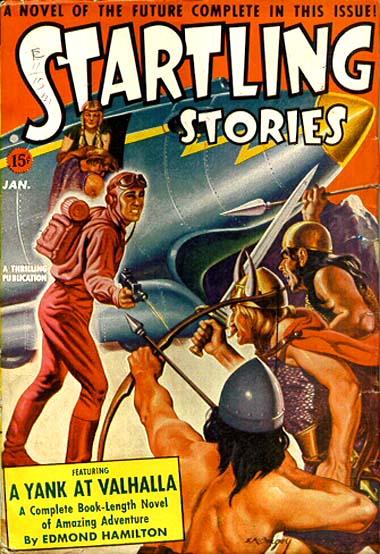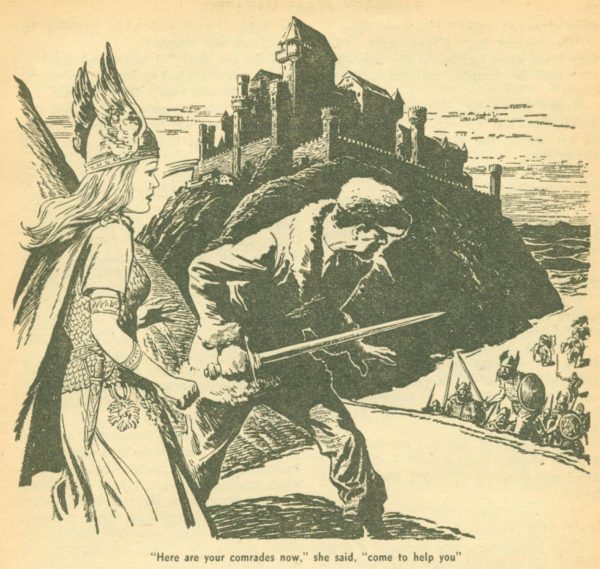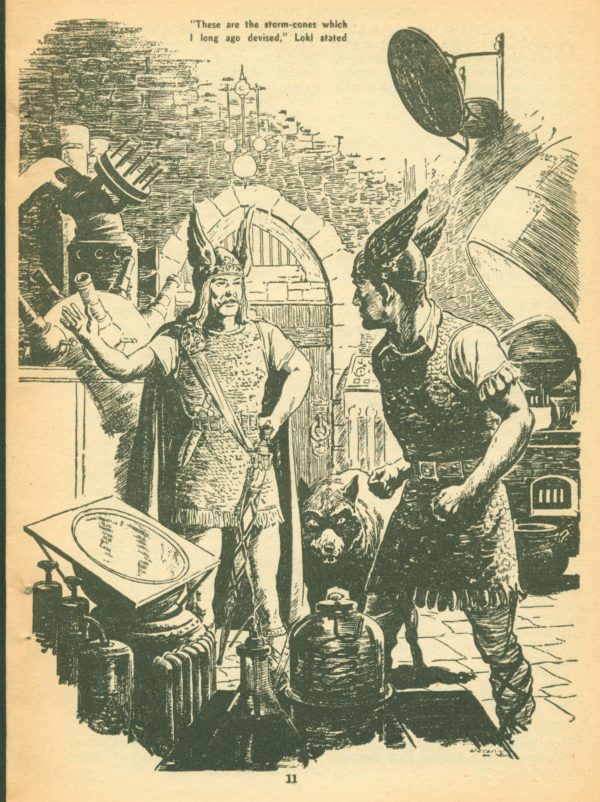A Yank At Valhalla.
Not to let the hokey Twain-ist title fool you, Edmond Hamilton's A Yank at Valhalla delivers a Norse-inspired genre mash-up in fine pulp style.
Part lost civilization fantasy, part science fiction, Hamilton plays with the idea that behind mythology lies a greater truth.
Physicist Keith Masters, during an exploratory survey flight, gets blown into a hidden area of the arctic where he discovers the secret lands of the Norse Gods.
Stylewise, the many typos (a pulp given) are unexpectedly balanced out by some lovely .50-cent word selections, and it's neat shifting gears as a reader between scientific terms and medieval descriptors. This integrated juxtaposition aside, a lot of the presentation is stirring with cries of "Our swords for Asgard!", impressive feasting hall settings, and saga worthy melees & martial battles.
While the start isn't as fast as Lester Del Rey's The Day of the Giants (1950), they share a conceit that a mid-century modern man can think more clearly and problem solve better than an immortal, which here is still a false conceit, and one finds Masters a few times saying things like, "Score one for my science!" to convince us, but not successfully. Anachronistic of this, Masters flies a "rocket plane", which is more than bleeding edge technology in 1940, even for a well-funded polar expedition.
We suspect this early NorsePlay also possibly influenced Ian Cameron's Island At the Top of the World from 1961 where a polar foray stumbles onto a Viking civilization survival. And
the mix of high-tech with ancient dress reminds us of Stan Lee & Jack Kirby's Thor, which began in 1962, where the science is implied, but not overt, and one wonders if either of them read this beforehand.
In terms of what was going on in 1940, we have an American character with no horse in the race between the Aesir & the Jotuns, getting involved for various circumstantial reasons in what may very well become Ragnarok. This raises the question if Hamilton possibly wrote this as an appeal for a U.S. entry into WW2. While the text always has the battles as being against the odds, the Viking ethos of combat being a necessary facet to support civilization and that risk being celebrated is prominent in the novella.
With pulp motifs, A Yank at Valhalla also presents the idea of the hidden subterranean. Using the dwarves (here labeled the Alfings) and a radioactive Muspelheim as a pre-surface dwelling and advanced technological world, this presages The Shaver Mystery's pulps/memoirs by half a decade:
In a current young adult novel landscape of Riordan's Magnus Chase and Armstrong's The Blackwell Pages, where overweening teen sass underqualifies as optimism, going back to an early NorsePlay like Hamilton's A Yank At Valhalla yields more imaginative treasure.
 |
| [Original pulp from January 1941.] |
Part lost civilization fantasy, part science fiction, Hamilton plays with the idea that behind mythology lies a greater truth.
Physicist Keith Masters, during an exploratory survey flight, gets blown into a hidden area of the arctic where he discovers the secret lands of the Norse Gods.
 |
| [An Ace double version from 1973.] |
Stylewise, the many typos (a pulp given) are unexpectedly balanced out by some lovely .50-cent word selections, and it's neat shifting gears as a reader between scientific terms and medieval descriptors. This integrated juxtaposition aside, a lot of the presentation is stirring with cries of "Our swords for Asgard!", impressive feasting hall settings, and saga worthy melees & martial battles.
 |
| [UK re-titled version from 1950. And Freya's going to fall out of that top at any moment.] |
While the start isn't as fast as Lester Del Rey's The Day of the Giants (1950), they share a conceit that a mid-century modern man can think more clearly and problem solve better than an immortal, which here is still a false conceit, and one finds Masters a few times saying things like, "Score one for my science!" to convince us, but not successfully. Anachronistic of this, Masters flies a "rocket plane", which is more than bleeding edge technology in 1940, even for a well-funded polar expedition.
 |
| [Interior art from Fantastic Story 1953 January pulp.] |
We suspect this early NorsePlay also possibly influenced Ian Cameron's Island At the Top of the World from 1961 where a polar foray stumbles onto a Viking civilization survival. And
the mix of high-tech with ancient dress reminds us of Stan Lee & Jack Kirby's Thor, which began in 1962, where the science is implied, but not overt, and one wonders if either of them read this beforehand.
 |
| [More interior art from Fantastic Story 1953 January pulp.] |
In terms of what was going on in 1940, we have an American character with no horse in the race between the Aesir & the Jotuns, getting involved for various circumstantial reasons in what may very well become Ragnarok. This raises the question if Hamilton possibly wrote this as an appeal for a U.S. entry into WW2. While the text always has the battles as being against the odds, the Viking ethos of combat being a necessary facet to support civilization and that risk being celebrated is prominent in the novella.
 |
| [This same side-saddle valkyrie on colourless Bifrost art was also used for a later NorsePlay: Lester Del Rey's The Day of the Giants, except it was re-titled When the World Tottered.] |
With pulp motifs, A Yank at Valhalla also presents the idea of the hidden subterranean. Using the dwarves (here labeled the Alfings) and a radioactive Muspelheim as a pre-surface dwelling and advanced technological world, this presages The Shaver Mystery's pulps/memoirs by half a decade:
"This was no mere cavern, but an enormous hollow such as many have believed was left under the planet's surface by the hurling forth of the Moon." (p.96)
In a current young adult novel landscape of Riordan's Magnus Chase and Armstrong's The Blackwell Pages, where overweening teen sass underqualifies as optimism, going back to an early NorsePlay like Hamilton's A Yank At Valhalla yields more imaginative treasure.
# # #
Guillermo Maytorena IV knew there was something special in the Norse Lore when he picked up a copy of the d'Aulaires' Norse Gods and Giants at age seven. Since then he's been fascinated by the truthful potency of Norse Mythology, passionately read & studied, embraced Ásatrú, launched the Map of Midgard project, and spearheaded the neologism/brand NorsePlay. If you have employment/opportunities in investigative mythology, field research, or product development to offer, do contact him.


Comments
Post a Comment